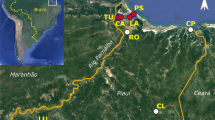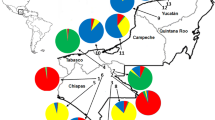Abstract
Michelia formosana is distributed islandwide in Taiwan and also occurs in the Ryukyu Archipelago, Japan. Allozyme genetic variability in M. formosana (Magnoliaceae) was investigated using five polymorphic loci (Pgm-1, Idh-1, Mr-1, Skdh-1, and Ppo-3) from five enzyme systems. The average value of expected heterozygosity (He) describing within-population variation was 0.241. The overall Fis (0.0736) indicates a significant deficiency of heterozygotes at the population level. This positive value of Fis is mainly contributed from populations found at Pinglin, Chienshi, Wufeng, and the Ryukyus, all located at northern latitudes, and is also caused by locus Ppo-3. Among-population variation, Fst, accounted for 10.6% of the total heterozygosity and deviates significantly from zero. This populational differentiation agrees well with that of general tropical woody species outcrossed by animals. The population on Lanyu (Orchid Island) has some morphological differences from the plants native to Taiwan, but this was not reflected in the cluster analysis using the unweighted pair group method. Pgm-1d, however, is the diagnostic characteristic for the plants growing on Lanyu as it is entirely absent from all other populations of M. formosana. About 18% of the alleles of this study show clinal geographical variation and were found to be significantly related to latitudinal gradients throughout the species range. This, however, is not a linear relation but a curve with a peak form which is exactly the same as the relationship between expected heterozygosities of populations and latitude. This observation suggests that Nantou County, in central Taiwan could be a glacial refugium for genetic diversity of M. formosana. This inference is further supported by analysis of published studies on seven widely spread plant species in Taiwan. Location of this glacial refugium is probably related to the first emergence of the Central Mountain Ridge millions of years ago that naturally becamed the major window to receive genetic diversity from the Asian mainland.
Similar content being viewed by others
Author information
Authors and Affiliations
Additional information
Received: 16 April 2000 / Accepted: 12 May 2000
Rights and permissions
About this article
Cite this article
Lin, TP. Allozyme variations in Michelia formosana (Kanehira) Masamune(Magnoliaceae), and the inference of a glacial refugium in Taiwan. Theor Appl Genet 102, 450–457 (2001). https://doi.org/10.1007/s001220051666
Issue Date:
DOI: https://doi.org/10.1007/s001220051666




